Abstract
An abattoir survey was undertaken to determine the prevalence of leptospirosis and its association with lesions of multifocal interstitial nephritis (so-called "white spotted kidneys") in swine at slaughter. Both cross-sectional and case-control study designs were used. Of 197 kidneys from hogs randomly selected at slaughter, 11 (5.6%) had generalized grey-white foci typical of multifocal interstitial nephritis (MFIN). Antibody titers greater than or equal to 1:80 against Leptospira pomona were detected in nine (4.6%) hogs and against L. bratislava in 63 (32%) of these hogs. Leptospira pomona (kennewicki) was detected by immunofluorescence in 5/197 (2.5%) of randomly selected hogs. Leptospires identified as genotype kennewicki were isolated from six (9.8%) of 61 kidneys cultured. Leptospira bratislava was not detected by immunofluorescence or culture. There was a highly significant (p = 0.00) and strong association (odds ratio (OR) = 195) between high L. pomona titer (greater than or equal to 1:80) and the presence of leptospires in the kidneys, as detected by culture. There was also a significant (p = 0.046) and strong (OR = 8.10) association between multifocal interstitial nephritis and the presence of renal leptospires as detected by culture. The association between leptospiral titer and MFIN lesions in the prevalence survey group of animals was statistically significant (p = 0.031), but this association was not significant in the case-control study group (p = 0.071) The failure to identify L. bratislava despite serological evidence of infection suggests that some of these seropositive animals may have been transiently infected at an early age, that serological findings were falsely positive, or that immunofluorescence and isolation attempts failed to detect L. bratislava if they were indeed present in the kidneys.(ABSTRACT TRUNCATED AT 250 WORDS)
Full text
PDF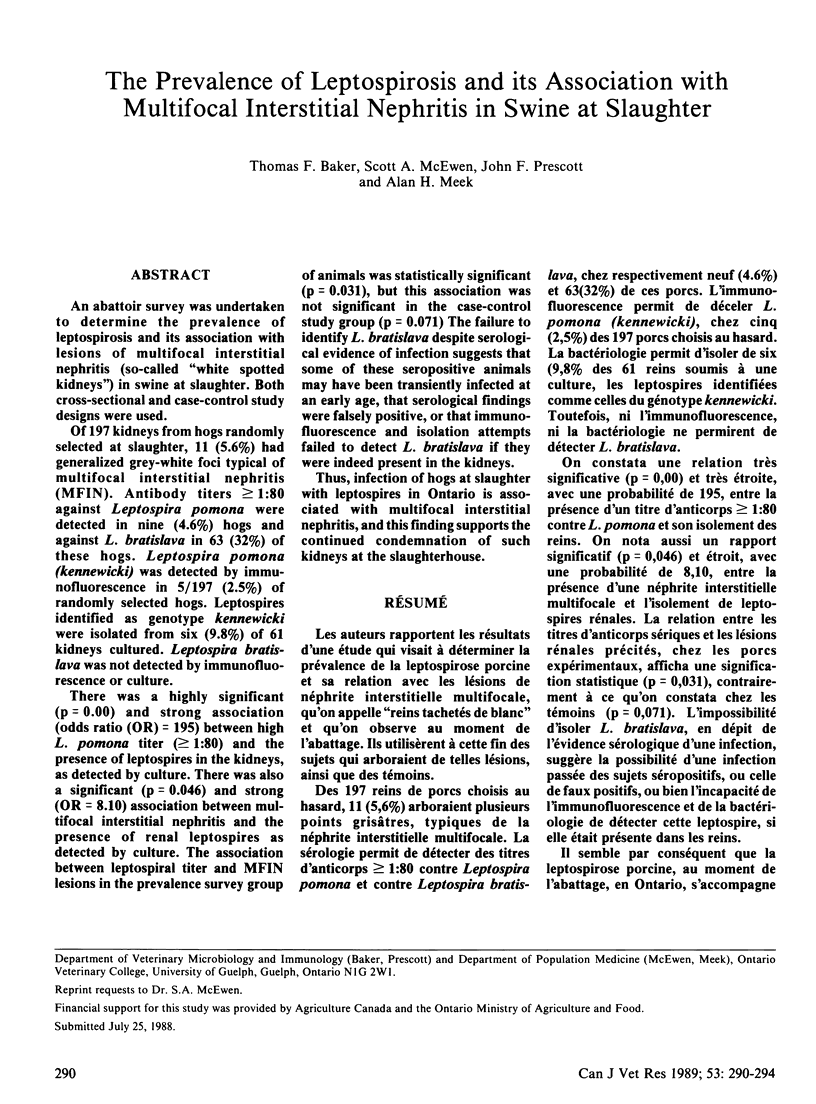
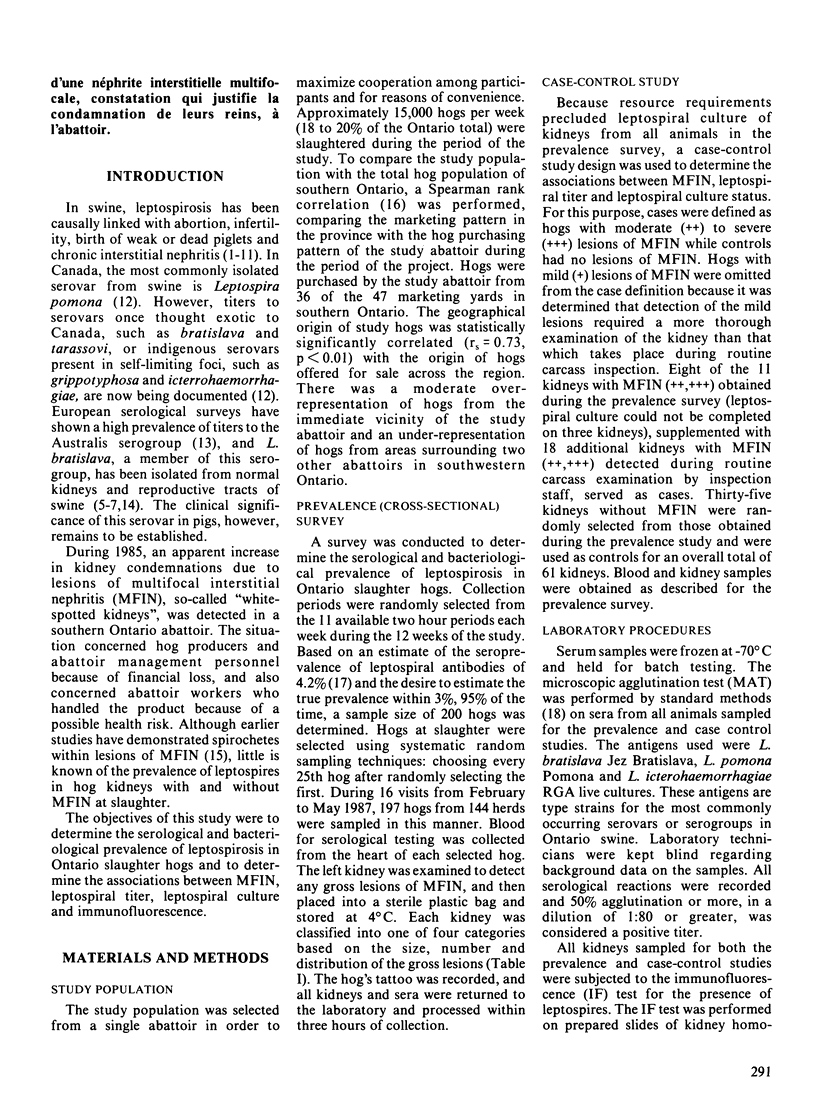
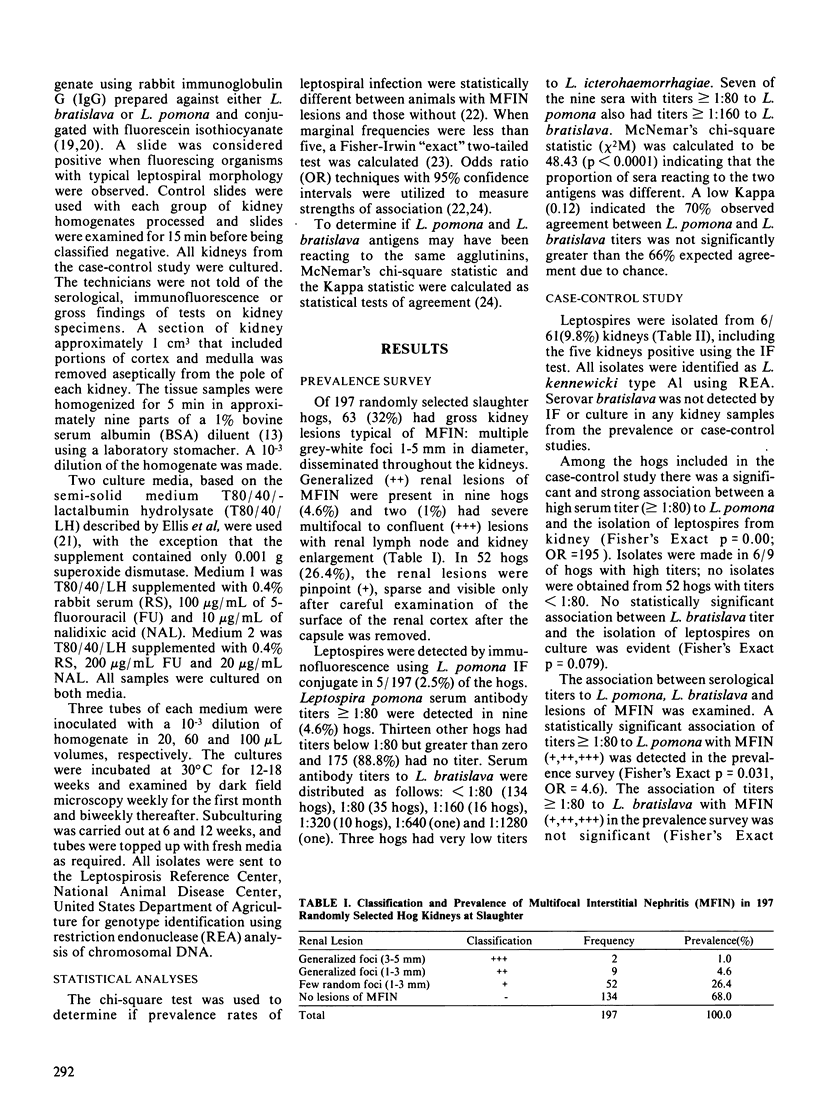
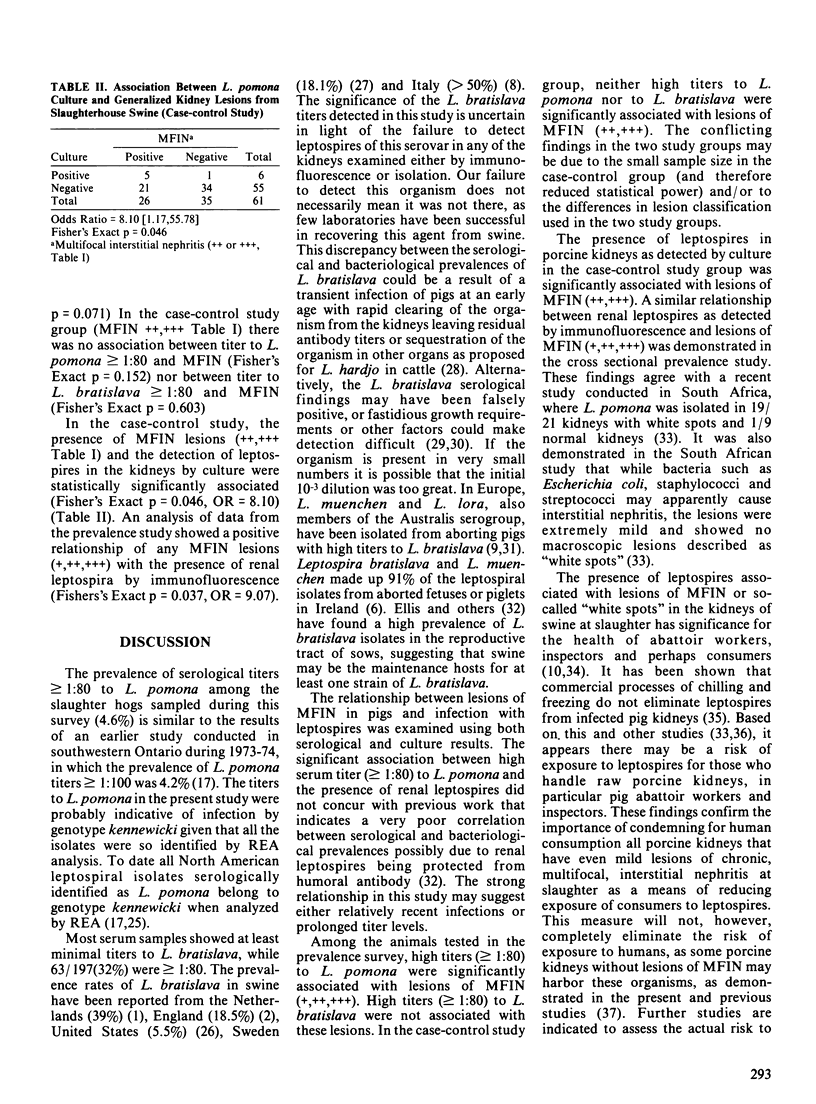
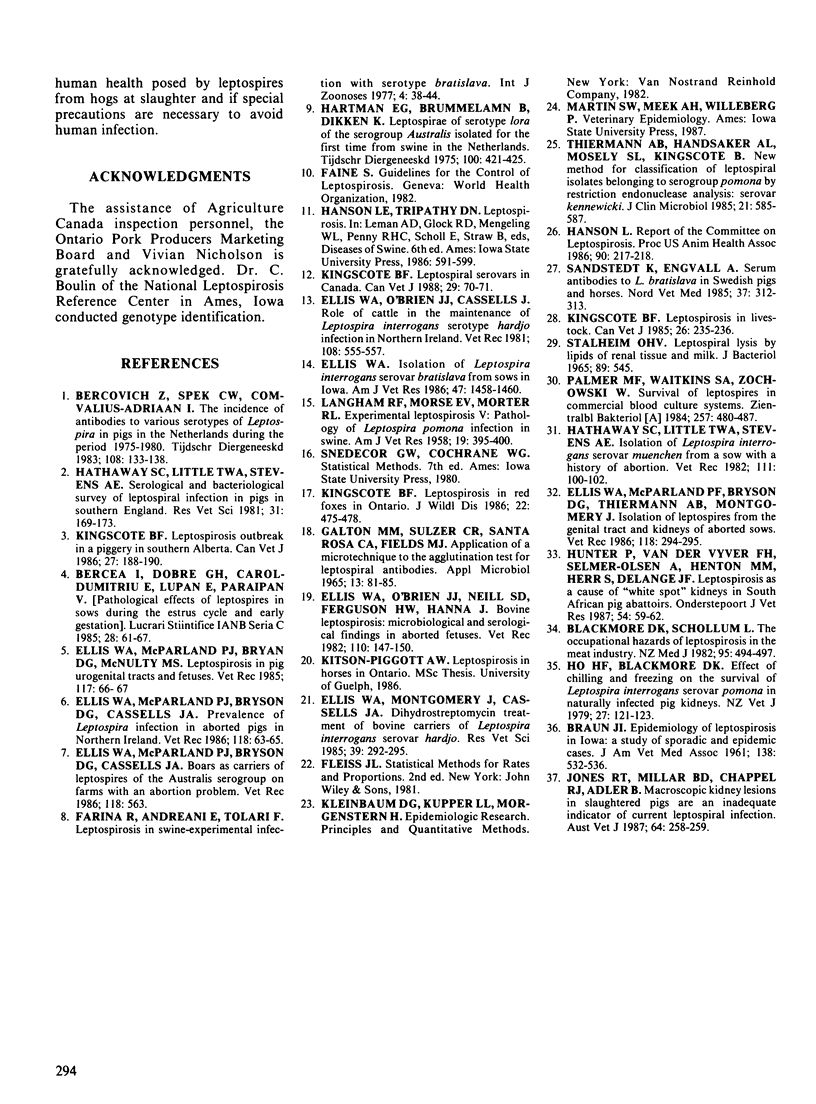
Selected References
These references are in PubMed. This may not be the complete list of references from this article.
- Blackmore D. K., Schollum L. The occupational hazards of leptospirosis in the meat industry. N Z Med J. 1982 Jul 28;95(712):494–497. [PubMed] [Google Scholar]
- Cross-Canada disease report. Can Vet J. 1988 Jan;29(1):70–71. [PMC free article] [PubMed] [Google Scholar]
- Ellis W. A., McParland P. J., Bryson D. G., Cassells J. A. Boars as carriers of leptospires of the Australis serogroup on farms with an abortion problem. Vet Rec. 1986 May 17;118(20):563–563. doi: 10.1136/vr.118.20.563. [DOI] [PubMed] [Google Scholar]
- Ellis W. A., McParland P. J., Bryson D. G., Cassells J. A. Prevalence of Leptospira infection in aborted pigs in Northern Ireland. Vet Rec. 1986 Jan 18;118(3):63–65. doi: 10.1136/vr.118.3.63. [DOI] [PubMed] [Google Scholar]
- Ellis W. A., McParland P. J., Bryson D. G., McNulty M. S. Leptospires in pig urogenital tracts and fetuses. Vet Rec. 1985 Jul 20;117(3):66–67. doi: 10.1136/vr.117.3.66. [DOI] [PubMed] [Google Scholar]
- Ellis W. A., McParland P. J., Bryson D. G., Thiermann A. B., Montgomery J. Isolation of leptospires from the genital tract and kidneys of aborted sows. Vet Rec. 1986 Mar 15;118(11):294–295. doi: 10.1136/vr.118.11.294. [DOI] [PubMed] [Google Scholar]
- Ellis W. A., Montgomery J., Cassells J. A. Dihydrostreptomycin treatment of bovine carriers of Leptospira interrogans serovar hardjo. Res Vet Sci. 1985 Nov;39(3):292–295. [PubMed] [Google Scholar]
- Ellis W. A., O'Brien J. J., Cassells J. Role of cattle in the maintenance of Leptospira interrogans serotype hardjo infection in Northern Ireland. Vet Rec. 1981 Jun 27;108(26):555–557. doi: 10.1136/vr.108.26.555. [DOI] [PubMed] [Google Scholar]
- Ellis W. A., O'Brien J. J., Neill S. D., Ferguson H. W., Hanna J. Bovine leptospirosis: microbiological and serological findings in aborted fetuses. Vet Rec. 1982 Feb 13;110(7):147–150. doi: 10.1136/vr.110.7.147. [DOI] [PubMed] [Google Scholar]
- Ellis W. A., Thiermann A. B. Isolation of Leptospira interrogans serovar bratislava from sows in Iowa. Am J Vet Res. 1986 Jul;47(7):1458–1460. [PubMed] [Google Scholar]
- Farina R., Andreani E., Tolari F. Leptospirosis in swine--experimental infection with serotype bratislava. Int J Zoonoses. 1977 Jun;4(1):38–44. [PubMed] [Google Scholar]
- GALTON M. M., SULZER C. R., SANTAROSA C. A., FIELDS M. J. APPLICATION OF A MICROTECHNIQUE TO THE AGGLUTINATION TEST FOR LEPTOSPIRAL ANTIBODIES. Appl Microbiol. 1965 Jan;13:81–85. doi: 10.1128/am.13.1.81-85.1965. [DOI] [PMC free article] [PubMed] [Google Scholar]
- Hartman E. G., Brummelman B., Dikken H. Leptospirae of serotype lora of the serogroup Australis isolated for the first time from swine in the Netherlands. Tijdschr Diergeneeskd. 1975 Apr 15;100(8):421–425. [PubMed] [Google Scholar]
- Hathaway S. C., Little T. W., Stevens A. E. Isolation of Leptospira interrogans serovar muenchen from a sow with a history of abortion. Vet Rec. 1982 Jul 31;111(5):100–102. doi: 10.1136/vr.111.5.100. [DOI] [PubMed] [Google Scholar]
- Hathaway S. C., Little T. W., Stevens A. E. Serological and bacteriological survey of leptospiral infection in pigs in southern England. Res Vet Sci. 1981 Sep;31(2):169–173. [PubMed] [Google Scholar]
- Ho H. F., Blackmore D. K. Effect of chilling and freezing on survival of Leptospira interrogans serovar pomona in naturally infected pig kidneys. N Z Vet J. 1979 Jun;27(6):121–123. doi: 10.1080/00480169.1979.34622. [DOI] [PubMed] [Google Scholar]
- Hunter P., van der Vyver F. H., Selmer-Olsen A., Henton M. M., Herr S., de Lange J. F. Leptospirosis as a cause of "white spot" kidneys in South African pig abattoirs. Onderstepoort J Vet Res. 1987 Mar;54(1):59–62. [PubMed] [Google Scholar]
- Jones R. T., Millar B. D., Chappel R. J., Adler B. Macroscopic kidney lesions in slaughtered pigs are an inadequate indicator of current leptospiral infection. Aust Vet J. 1987 Aug;64(8):258–259. doi: 10.1111/j.1751-0813.1987.tb09700.x. [DOI] [PubMed] [Google Scholar]
- Kingscote B. F. Leptospirosis in livestock. Can Vet J. 1985 Aug;26(8):235–236. [PMC free article] [PubMed] [Google Scholar]
- Kingscote B. F. Leptospirosis in red foxes in Ontario. J Wildl Dis. 1986 Oct;22(4):475–478. doi: 10.7589/0090-3558-22.4.475. [DOI] [PubMed] [Google Scholar]
- Kingscote B. F. Leptospirosis outbreak in a piggery in southern alberta. Can Vet J. 1986 Apr;27(4):188–190. [PMC free article] [PubMed] [Google Scholar]
- LANGHAM R. F., MORSE E. V., MORTER R. L. Experimental leptospirosis. V. Pathology of leptospira pomona infection in swine. Am J Vet Res. 1958 Apr;19(71):395–400. [PubMed] [Google Scholar]
- Palmer M., Waitkins S. A., Zochowski W. Survival of leptospires in commercial blood culture systems. Zentralbl Bakteriol Mikrobiol Hyg A. 1984 Sep;257(4):480–487. [PubMed] [Google Scholar]
- STALHEIM O. H. LEPTOSPIRAL LYSIS BY LIPIDS OF RENAL TISSUE AND MILK. J Bacteriol. 1965 Feb;89:545–545. doi: 10.1128/jb.89.2.545-545.1965. [DOI] [PMC free article] [PubMed] [Google Scholar]
- Sandstedt K., Engvall A. Serum antibodies to Leptospira bratislava in Swedish pigs and horses. Nord Vet Med. 1985 Sep-Oct;37(5):312–313. [PubMed] [Google Scholar]
- Thiermann A. B., Handsaker A. L., Moseley S. L., Kingscote B. New method for classification of leptospiral isolates belonging to serogroup pomona by restriction endonuclease analysis: serovar kennewicki. J Clin Microbiol. 1985 Apr;21(4):585–587. doi: 10.1128/jcm.21.4.585-587.1985. [DOI] [PMC free article] [PubMed] [Google Scholar]


